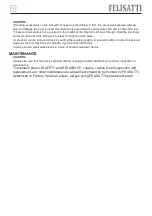
19
NOTE:
•
The side grip cannot swing 360° when the depth gauge is installed.
Installing or removing drill bit
To install the bit, place it in the chuck as far as it will
go. Tighten the chuck by hand. Place the chuck key
in each of the three holes and tighten clockwise. Be
sure to tighten all three chuck holes evenly.
To remove the bit, turn the chuck key
counterclockwise in just one hole, then loosen the chuck by hand. After using the chuck
key, be sure to return to the original position.
Depth gauge
The depth gauge is convenient for drilling holes of
uniform depth. Loosen the side grip and insert the
depth gauge into the hole in the side grip. Adjust the
depth gauge to the desired depth and tighten the
side grip.
NOTE:
•
The depth gauge cannot be used at the position where the depth gauge strikes against the tool body.
OPERATION
Hammer drilling operation
CAUTION:
•
There is a tremendous and sudden twisting force exerted on the tool/bit at the time of hole breakthrough,
when the hole becomes clogged with chips and particles, or when striking reinforcing rods embedded in the
concrete. Always use the side grip (auxiliary handle) and firmly hold the tool by both side grip and switch
handle during operations. Failure to do so may result in the loss of control of the tool and potentially severe
injury.
When drilling in concrete, granite, tile, etc., move the action mode changing lever to the
position of symbol to use “rotation with hammering” action. Be sure to use a
tungsten-carbide tipped bit. Position the bit at the desired location for the hole, then pull
the switch trigger. Do not force the tool. Light pressure gives best results. Keep the tool in
position and prevent it from slipping away from the hole. Do not apply more pressure
when the hole becomes clogged with chips or particles. Instead, run the tool at an idle,
and then remove the bit partially from the hole. By repeating this several times, the hole
will be cleaned out and normal drilling may be resumed.
Drilling operation
When drilling in wood, metal or plastic materials, move the action mode changing lever to
the position of symbol to use “rotation only” action.
Drilling in wood
When drilling in wood, the best results are obtained with wood drills equipped with a
guide screw. The guide screw makes drilling easier by pulling the bit into the work piece.
Drilling in metal
To prevent the bit from slipping when starting a hole, make an indentation with a
center-punch and hammer at the point to be drilled. Place the point of the bit in the
indentation and start drilling. Use a cutting lubricant when drilling metals. The exceptions
are iron and brass which should be drilled dry.
Summary of Contents for F91199
Page 1: ...F91199 13 800 RU EN IMPACT DRILL...
Page 2: ...2 2...
Page 3: ...1 1 6 4 7 10 11 5 2 3 8 9...
Page 4: ...4 1 5 2 7 1 9 2 9 3 9 4 10 5 10 6 11 7 13 8 13 9 14 10 14 11 14...
Page 5: ...5 1 1 b 2 b d f 3 b...
Page 6: ...6 d f g i 4 b d f g...
Page 7: ...7 5 2...
Page 9: ...9 1 1 1 1 2 80 1 3 1 4 1 5 2 2 1 1 II 3 2 13 800 13 25 10 220 50 800 0 2800 48000...
Page 11: ...11 3 2 5 1 4 11 3 5 2 11 5 3 2 1 11 1 6 6 1 6 1 1 6 1 2 6 1 3 9 10 9 6 2 II 60745 1 6 3...
Page 12: ...12 6 4 2 11 10 15 6 5 1 2 3 4 2 3 6 6 6 7...
Page 13: ...13 7 7 1 2 8 8 1 Y 8 2...



































